Whether you’re scrambling through slick alpine streams or chasing shade on a lazy river, your water shoes can make or break the mission. The best pairs are equal parts amphibious and all-terrain: grippy, breathable, quick to dry, and unbothered by a little sand in the seams.
Gone are the days of clunky neoprene booties and tight rubber slip-ons that would fill with water and never fully drain. Sure, they got the job done, but you wouldn’t be caught dead wearing them beyond the put-in. Today’s water shoes and sandals strike a balance between performance and style, letting you move seamlessly from waterfront to town with dry feet and dignity.
Our crew of water-loving testers, ranging from professional river guides to weekend water warriors, put 13 shoes and sandals through the wringer. From high alpine lakes to technical whitewater, over rocky portages and sandy put-ins, here’s what held up when the rubber hit the river rock.
At a Glance
Best Sandal
Bedrock Cairn Evo 3D PRO Sandals
$140 at Bedrock
Size Range: 5-14 (men’s), 6-15 (women’s)
Comfort Rating: 8/10
Traction Rating: 9/10
Pros and Cons
⊕ Three adjustable straps for customizable fit
⊕ Versatile enough for technical activities and casual wear
⊕ Exceptional durability
⊗ No half sizes
⊗ Minimal protection compared to closed-toe options
The Bedrock Cairn Evo 3D PRO hits a sweet spot between technical performance and everyday wear, making it our top pick for all-around water adventures. It’s the beefiest of Bedrock’s offerings, built with added sole structure compared to the more minimal models. With a three-point adjustable strap system, it offers a dialed-in fit that adapts to everything from rocky river scrambles to casual lakeside hangs.
“I can go anywhere with them,” said one tester who wore them on steep hikes, river crossings, and into town. The open-toe design sheds water instantly and dries fast. Most testers reported fully dry sandals in under an hour.
What really sets the Cairn Evo apart is its crossover appeal. Testers loved how easily it moved between trail and town, offering stable grip on slick surfaces thanks to a Vibram outsole, and minimalist construction that lets you easily shake out debris mid-hike—an annoyance that comes part and parcel with wearing sandals.
“They could overtake Chacos as my go-to sandal,” said one veteran river guide who logged serious miles across multiple rivers, including an 18-day Grand Canyon trip. The sandals held up impressively, showing only minor cosmetic wear. And when the tread finally wears down? Bedrock offers a resole program so you can extend the life of a well-loved pair instead of tossing them after a single season.
Just a heads-up: These shoes do not come in half sizes. If your toes flirt with the edge, consider sizing up.
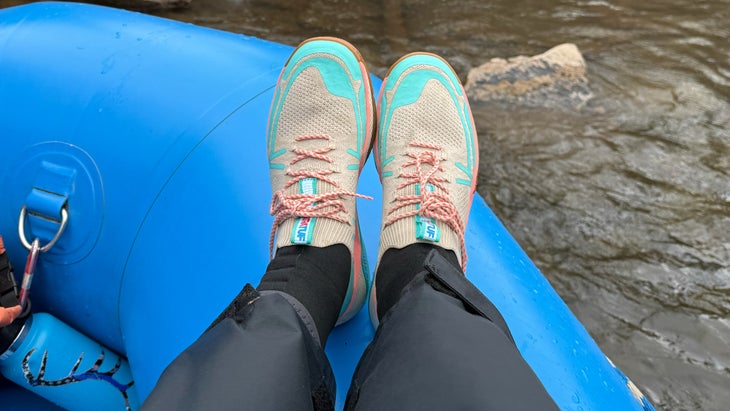
Best Sneaker
Xtratuf Kiata Drift Sneaker
$80 at Xtratuf (Women’s) $80 at Xtratuf (Men’s)
Size Range: 7-14 (men’s), 5-11 (women’s)
Comfort Rating: 7/10
Traction Rating: 8/10
Pros and Cons
⊕ Excellent traction on rocky terrain
⊕ Easy slip-on design
⊗ Not the most stylish
⊗ Slow to dry in cold conditions
The Xtratuf Kiata Drift Sneaker delivers solid all-around performance at a price point that won’t break the bank. This hybrid style bridges the gap between technical water shoes and everyday sneakers, making it a smart pick for anyone on a budget who wants one pair that can do it all.
“They performed like tennis shoes on dry land,” said one tester after boating on the Arkansas River. What stood out most was the grippy TUFgrp outsole, which proved reliable on slick river rocks, dry trails, and boat decks alike. The stretchy, unlined, engineered upper makes them easy to slip on and prevents hot spots around the ankle and heel, while the quick-drain design means you’re not sloshing around all day. “I couldn’t feel water retention at all,” noted another tester.
The style leans a bit utilitarian and the shoe was slow to dry in cold conditions, but the comfort and versatility make up for it. For boaters, casual hikers, and anyone seeking a reliable water shoe that can double as everyday footwear, this Xtratuf pair delivers where it counts without the premium price tag.
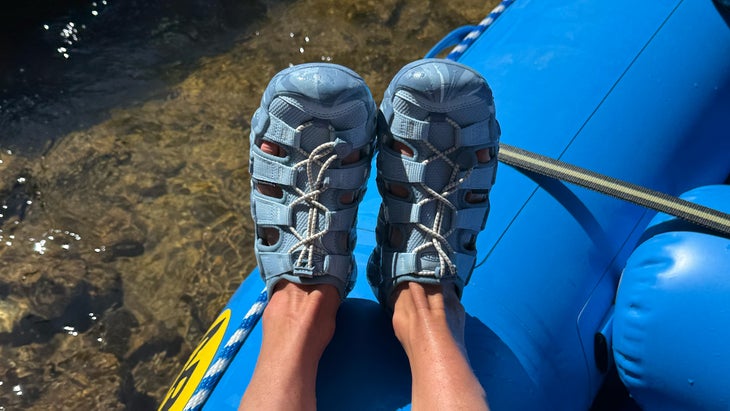
Best Hybrid Shoe
Keen Hyperport H2 Sandals
$120 at REI (Women’s) $120 at REI (Men’s)
Size Range: 7-17 (men’s), 5-11 (women’s)
Comfort Rating: 8/10
Traction Rating: 6/10
Pros and Cons
⊕ Exceptional comfort and cushioned footbed
⊕ Quick drainage and fast-drying
⊕ Great airflow and breathability
⊕ Wide size range for men
⊗ Limited traction on wet rocks
⊗ Pebbles can get trapped and are difficult to remove
For water lovers who value comfort over techy features, the Hyperport H2 delivers all-day wearability. With a plush, injected foam midsole and breathable design with strategically placed cutouts, it’s a solid pick for passenger rafters, beachgoers, or anyone logging long hours on a boat deck.
The comfort and footbed cushion stood out most to one tester after a day of rafting on Colorado’s Upper Taylor River. The sandal drains fast thanks to the side openings, dries quickly, and stays breathable even during hot, all-day wear. On dry land, it offers decent support and cushioning for casual walking or campground loops.
That said, the Hyperport H2 isn’t built for more demanding water or land terrain. Testers noted limited grip on slick rocks, so it’s not ideal for technical scrambles or strong current crossings. Debris can also be a nuisance: small pebbles tend to sneak in and stay there.
Still, for mellow summer floats, shoreline strolls, and easy river days, this sandal nails the comfort brief. If you’re looking for a laid-back, go-anywhere water shoe that prioritizes cushion over performance, the Hyperport H2 is an easy win.
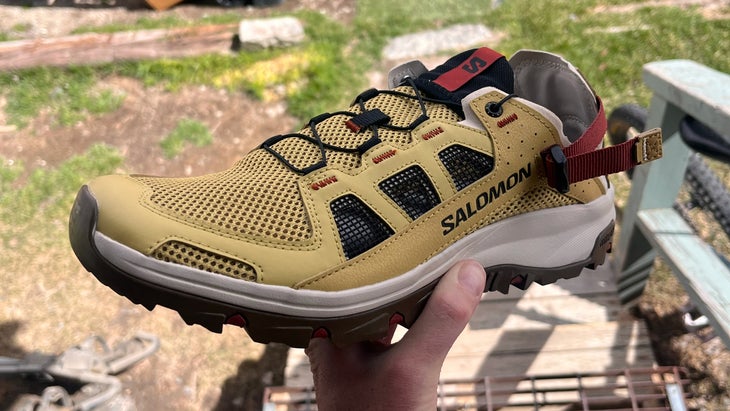
Best for Wet Trails
Salomon Techamphibian 5
$110 at REI (Women’s) $110 at Backcountry (Men’s)
Size Range: 7-14 (men’s), 5-11 (women’s)
Comfort Rating: 8/10
Traction Rating: 9/10
Pros and Cons
⊕ Superior traction on wet and slippery surfaces
⊕ Durable construction with excellent protection
⊕ Versatile for both water and trail use
⊗ More trail-focused sole than water-specific tread
The Salomon Techamphibian 5 stands out as a confident crossover option for those who want one shoe that can handle both water and trail. Tested in Class III whitewater in Colorado’s Browns Canyon, the shoe held its own across a range of terrain, offering reliable comfort through long, wet days. Its anti-debris mesh drains efficiently after full submersion and dries at a reasonable pace, ideal for mixed days that shift between paddling, hiking, and loading gear at the put-in.
But it’s not without limitations. In colder conditions where drysuits and neoprene socks come into play, the fit can get tricky. The collapsible heel design offers some versatility between slip-on and “sport mode,” but testers noted that it sacrificed some of the secure, locked-in feel needed for more technical river environments when wearing the shoes over neoprene socks.
“This shoe would be great for raft trips and kayaking alike,” one tester said, though he noted the sole felt more like a trail runner than a water-specific grip. If your days are evenly split between land and river, and you’re not in big whitewater or cold-weather gear, the Techamphibian 5 is a versatile choice.
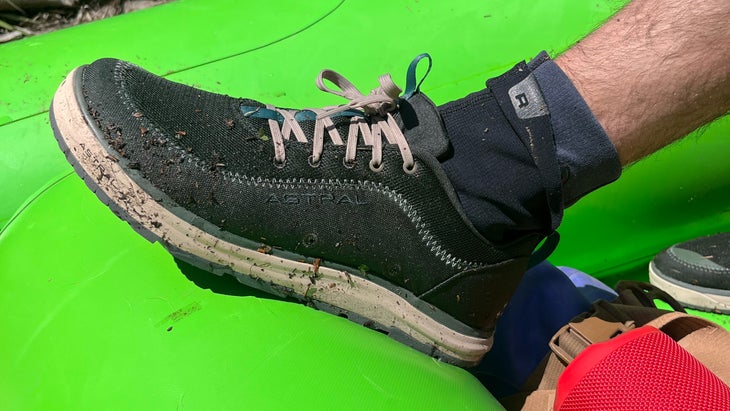
Best Classic River Shoe
Astral Brewer 3.0
$130-150 at REI $130 at Backcountry
Size Range: 5-12 (men’s), 6-13 (women’s)
Comfort Rating: 9/10
Traction Rating: 8/10
Pros and Cons
⊕ Stylish sneaker design with excellent drainage
⊕ Comfortable for all-day wear
⊕ Works well with neoprene socks for cold water
⊗ Sizing runs small
⊗ Durability concerns with heavy use
The Astral Brewer 3.0 has long been a favorite among river guides and seasoned paddlers, and for good reason. “They look good, are comfortable, and drain well,” said one tester, echoing a common refrain across the paddling community. The low-profile, sneaker-like aesthetic gives them a streetwear edge that most water shoes don’t have, without sacrificing grip, drainage, or comfort. Even better, they still fit great when worn with neoprene socks.
With a super-sticky rubber outsole designed for wet, uneven surfaces, plus quick-dry canvas and breathable mesh in the upper, testers reported stable performance across everything from early-season runoff to hot, sandy beaches. “They’re grippy on wet rocks and feel trustworthy in variable terrain,” said one paddler who wore them through Class III-IV conditions. However, testers recommend sizing up to accommodate thicker socks or drysuits.
While the Brewer excels in comfort and style, durability emerged as a concern. “They wear out fast with heavy use,” reported one tester, though testers were willing to overlook this given the shoe’s versatility and reasonable price point. For those seeking a water shoe that transitions seamlessly from Class III rapids to post-float town hangs, the Astral Brewer 3.0 remains the gold standard that has influenced an entire category of footwear.
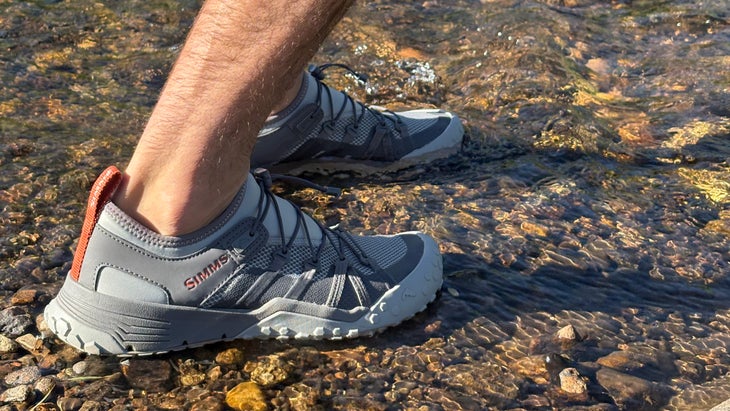
Best for Rocky Terrain
Simms Pursuit Shoe
$140 at Backcountry $140 at Simms
Size Range: 5-14 (men’s), 7-16 (women’s)
Comfort Rating: 8/10
Traction Rating: 10/10
Pros and Cons
⊕ Exceptional toe protection for rocky terrain
⊕ Outstanding grip on wet and slippery surfaces
⊕ Durable construction built for rugged use
⊗ Runs small in sizing
⊗ Takes longer to drain after full submersion
The Simms Pursuit Shoe shines in rocky rivers and technical terrain where protection and grip matter most. Originally built for fly fishing, it’s equally well-suited for rafting, guiding, or any water-based adventure requiring confident footing on wet rocks and uneven surfaces.
“These are so solid—I never worried about where I was stepping,” said one professional raft guide who wore them on shallow, rock-strewn rivers. Testers consistently rated the Pursuit as having the best traction in the lineup, thanks to its aggressive lug pattern and reinforced TPU overlay toe caps that guard against painful stubs.
The shoe’s burly slip-resistant outsole construction prioritizes durability over quick-drying convenience. They take a little longer to drain and dry compared to more open styles, but the tradeoff is worth it for the security and protection they provide. The paracord lacing system with a locking toggle keeps the fit secure all day, and testers appreciated the reliability over flimsier bungee systems.
One caveat: These run small, especially for women, so sizing up is key. Despite that, the Pursuit earned high marks for confidence-inspiring grip, comfort, and bombproof build quality. For water users tackling rough terrain, this shoe delivers exactly what you want for navigating challenging rocky terrain.
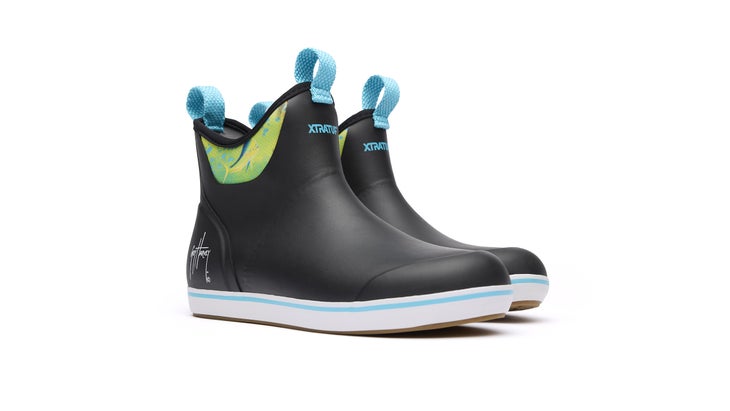
Paid Advertisement by XTRATUF
XTRATUF Guy Harvey Ankle Deck Boots
Shop Now
For summer adventure on land or on the water, slip on XTRATUF Ankle Deck Boots. These iconic non-slip, waterproof boots now feature marine artwork by acclaimed artist and conservationist Dr. Guy Harvey. Plus, a portion of proceeds benefit ocean conservation and marine science education through the Guy Harvey Foundation.

Best Flip Flop
Chaco Rapid Pro Flip Flop
$100 at Backcountry (Women’s) $100 at Backcountry (Men’s)
Size Range: 7-15 (men’s), 5-12 (women’s)
Comfort Rating: 8/10
Traction Rating: 7/10
Pros and Cons
⊕ Exceptional versatility across multiple activities
⊕ Reliable traction on varied terrain
⊗ Limited security in water activities
⊗ Inherent flip-flop limitations for technical use
The Chaco Rapid Pro Flip Flop walks the line between casual comfort and legit outdoor function, making it a solid pick for anyone who wants one sandal that can handle water, trail, and town without missing a step. Our tester praised its versatility across every kind of terrain, from rocky riverbeds to sandy beaches.
“I’d recommend them for their comfort and versatility,” said one Colorado-based tester who used them for moderate climbing approaches, rafting, and daily wear. “They’re great for everything from floating the river to hanging at the coffee shop.” The footbed offers Chaco’s signature support, and the rugged outsole held up to repeated use without showing much wear.
Of course, it’s still a flip-flop. You’re not getting full-foot security or toe protection, and they’re not ideal for technical terrain or swift water. But for everyday summer adventures where you don’t need to be locked in, they get the job done in comfort and style.
If you’re looking for a dependable sandal to cover your bases until it’s time to lace up something more specialized, the Chaco Flip Flop brings surprising capability to the table.
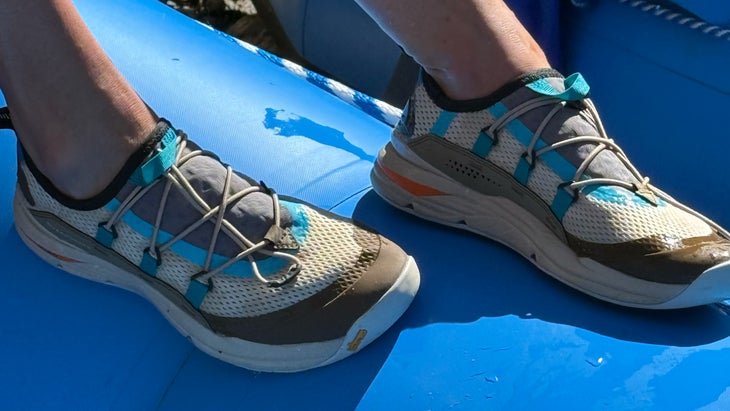
Most Versatile
Danner Rivercomber
$130 at Backcountry $130 at Danner
Size Range: 7-14 (men’s), 5-11 (women’s)
Comfort Rating: 8/10
Traction Rating: 8/10
Pros and Cons
⊕ Excellent for trail-to-water transitions
⊕ Lightweight with good wet rock traction
⊕ Stylish enough for casual wear
⊗ Tight opening makes them difficult to put on
⊗ Not ideal for muddy conditions
The Danner Rivercomber nails the balance between style and function, earning our top pick for versatility. Lightweight and quick-drying, it transitions seamlessly from trail to river; but what really sets it apart is how naturally it fits into every part of the day. It’s structured enough for short hikes and stable enough for river crossings, but with a streamlined, low-profile design, it doesn’t scream “technical footwear.”
“They were comfortable and stable,” said one tester after wearing them on the Yampa and Upper Taylor Rivers. The Rivercomber held up well across varied conditions, from deep desert canyons to chilly mountain streams. The shoe features a sock-like fit with stretch-mesh construction and no traditional lacing system, instead relying on a snug slip-on design that hugs the foot. It dries quickly, usually within a few hours in the sun, and sheds water well thanks to its mesh construction and drainage ports.
The snug fit has its drawbacks though. Several testers noted the shoe is tough to get on due to a tight opening that isn’t easily adjustable, and the secure fit that’s great for in-water use can feel restrictive over longer stretches. Traction is solid on rock, but less dialed on muddy terrain.
For guides and casual users alike, the Rivercomber is a sharp-looking, all-around performer built for life on and around the water.
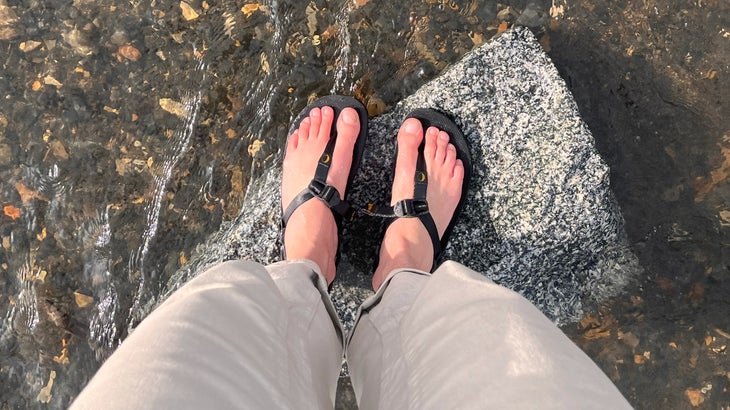
Other Water Shoes and Sandals We Tested
Luna Middle Bear Winged Edition Sandal ($120): These minimalist sandals impressed us with their lightweight design and exceptional traction, earning praise for handling rocky terrain and easily dumping debris thanks to their open construction. However, testers found the GEN3WINGS buckle system less comfortable and adjustable than competitors. The Lunas are still a solid choice for those who prioritize the barefoot feel and don’t mind spending time dialing in the fit.
Danner Wallowa Nylon Sandal ($130): These sandals stood out for their bombproof build and sharp aesthetic, with solid traction and durability across creeks, trails, and sandy riverbeds. But the single-strap design made it tough to dial in a secure fit, and the hefty soles felt bulky over time. Straps took overnight to dry, and overall comfort fell short for all-day water use. Stylish, but not our top pick for performance.
Teva Hydratrek Closed-Toe Water Sandal ($100): The Hydratrek delivers on comfort and basic water performance, but its bold design didn’t land with most of our testers. While the shoe handles mellow water activities just fine, its eccentric, bulky and color-blocked styling limits its versatility for casual users who want something more understated. If you’re looking strictly for function, it’ll do the trick. But for those who care about post-float wearability and a more streamlined look, the Keen Hyperport H2 came out ahead.
La Sportiva TX Canyon ($209): Originally built for canyoneering, this rugged approach shoe has become a go-to for professional whitewater guides and rescue teams who need max protection and grip in extreme terrain. With bomber construction, sticky Vibram rubber, and a reinforced upper, it outperformed most true water shoes in high-consequence environments. “They’re not designed for whitewater, but they’re what every other water shoe should be aiming for,” said one tester.
That said, it’s not for casual users. It retains water, doesn’t drain quickly, and is too bulky for tight playboats. But for those working daily in gnarly river terrain, the TX Canyon is unmatched. Just know you’re strapping on more of a mountain boot than a summer sandal.
Frequently Asked Questions
What’s the Difference Between Water Shoes and Waterproof Shoes?
Waterproof shoes are designed to keep water out, using materials like Gore-Tex or other water-resistant membranes. Great for rainy hikes or slushy streets, but once they’re wet on the inside? Game over.
Water shoes, on the other hand, are built to get wet. They’re designed for traction on slick rocks, protection from sharp riverbeds, and fast drainage when you’re in and out of the water. Whether you’re paddleboarding, scrambling along a rocky coastal or lakeside shoreline, or hopping off the raft for a side hike, water shoes are made to dry quickly, shed debris, and keep you on your feet, not sliding around on them.
How Should Water Shoes Fit?
A good water shoe should fit snug. Too loose and you’ll be slipping around inside the shoe. Too tight and you’ll regret it halfway through a portage. If you’re wearing them barefoot in warm weather, look for a true-to-size fit with just enough room up front to wiggle your toes. For colder water or shoulder seasons, you’ll want to size up slightly to accommodate neoprene socks or liners. Keep in mind that some models stretch a bit once wet, and others don’t give at all. Materials like mesh or knit tend to mold to your foot over time, while burlier rubberized options stay rigid.
Should I Wear Socks with Water Shoes?
It depends on where you’re headed and how long you’re out. For quick dips, mellow floats, or SUP laps around the lake, barefoot works just fine. But if you’re clocking longer hours on the river, hiking to remote put-ins, or dealing with colder water, socks start to make a big difference. Neoprene socks are the go-to for chilly conditions because they add warmth without sacrificing too much dexterity. For warmer weather, lightweight wool or synthetic socks can help prevent blisters and cut down on that soggy-foot friction. Just remember, if you’re planning to wear socks, especially bulkier neoprene ones, size up accordingly.
Can I Wear Water Shoes for Hiking or Different Activities?
You can, but not all water shoes are built the same, and not all trails are forgiving. Some models are purpose-built for water: lightweight, minimal, and made to drain fast. Great for paddleboarding, canyoneering, or rocky beach scrambles, but maybe not the best choice for grinding out miles with a heavy pack.
Others are true hybrids: beefier soles, more foot support, and enough structure to handle light hiking, side trails, or hauling gear to and from the put-in.
If you’re fishing or wading, look for options with low profiles and stealthy tread. For SUPing, lightweight and grippy is key. Whitewater? You want something that won’t come off mid-swim and protects your toes. Bonus if they look good enough to pass for streetwear when you roll into town for post-float tacos.
So yes, water shoes can multitask, but the right pick depends on how, and where, you plan to roam.
Are Water Shoes Worth It Compared to Just Wearing Old Sneakers or Sandals?
Sure, you can wear your old running shoes on the water, but you’ll probably regret it by lunchtime. Water shoes are designed specifically for wet, uneven terrain. They drain fast, grip slippery surfaces, and dry out quickly. No sloshing around hours after you’ve left the water.
So yeah… they’re worth it. Once you try a real water shoe, you’ll wonder why you ever lugged a soaked pair of sneakers up a canyon in the first place.
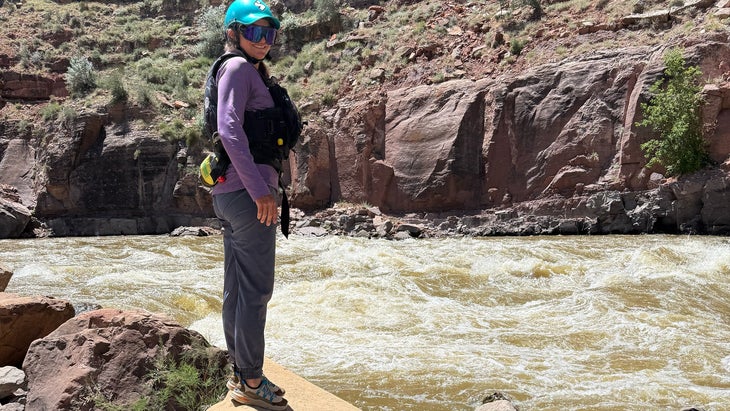
How We Test
- Number of testers: 5
- Number of products tested: 13
- Bodies of water tested in: 8
- Number of rocks slipped on: 4
- Number of trapped pebbles: Too many to count!
Our crew of testers ranged from professional whitewater guides to weekend river warriors; people who play in and around water every day and know what works (and what doesn’t). Over several months, we put this year’s crop of water shoes to the test on the iconic Yampa River in Dinosaur National Monument and the technical flows of the Arkansas, with side trips to alpine lakes and icy headwater streams.
Each pair was tested in the kinds of real-world scenarios that actually matter: scrambling over mossy riverbank boulders, scouting rapids, balancing on SUP boards, and hiking into remote put-ins. We wore them through long days on Class III whitewater and walks around town for post-river brews.
We focused on the fundamentals: grip on slick rocks (nobody wants an unplanned swim), drainage after full submersion, all-day comfort, and durability under real river abuse. We also paid attention to how they handled dry land, because the best water shoes shouldn’t leave you sloshing.
And beyond pure performance, we considered the little things: how easy they are to slip on when your hands are full of gear, whether they stay put when you’re swimming, and if they’re something you’d actually wear off the river. Because the best water shoe is the one you’ll keep reaching for, whether you’re headed out on a multi-day mission or for a float around your neighborhood lake.
Meet Our Lead Tester
Skylar Kraatz is a writer, gear tester, and amphibious enthusiast based in Crested Butte, Colorado. She’s guided rivers across Southwest Colorado, from the Dolores to the San Miguel, and has twice ventured down the Big Ditch (aka the Grand Canyon). When she’s not on the river, you’ll find her exploring alpine lakes in the high country. Her work has appeared in SKI Magazine, Warren Miller, and beyond.
More Gear Reviews
The Best Backpacks, Duffels, and Roller Bags for Adventure Travel
The 3 Best Action Cameras of 2025
The Best Tents for Car Camping
